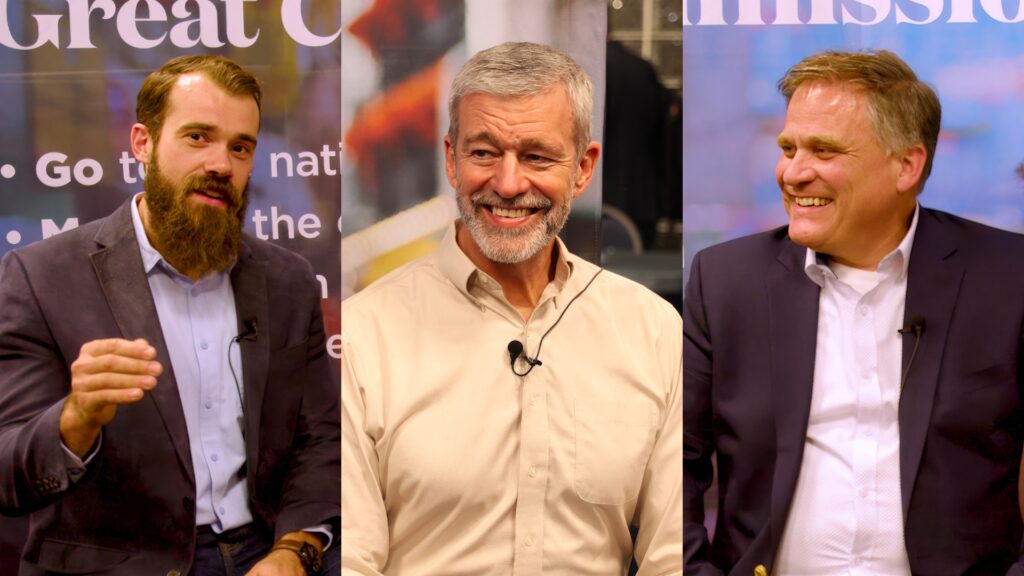Despite the Americanized ambiance of our meeting place, sheikh Ahmad was unmistakably from the Middle East. He wore the traditional garb of an Islamic pilgrim, spoke exclusively in Islamic Arabic, and throughout our conversation he mentioned that he was the Friday preacher in a local mosque.
The cultural juxtaposition of a Middle Eastern man wiping Big Mac sauce out of his beard while looking out over the Mediterranean Sea, however, was not the greatest contrast I experienced that day. In the process of speaking with the sheikh, I discovered that he believed that salvation is found in Isa (the Qur’an’s name for Jesus). Even though he preaches from the Qur’an in the local mosque, he stated that he specifically chooses the places that speak of Isa in order to slowly lead people to saving faith within the mosque. That day, sheikh Ahmad provided me with my first exposure to what missiologists call the Insider Movement (IM).
Defining Insider Movement Terminology
If this is the first that you are encountering IM, this four-part series will orient you to the missiological discussion. For those already familiar with the discussion, this series intends to help you assess the theological and missiological foundations upon which IM practices are built. Though this series cannot address the nuances of every IM expression among Muslims, it aims to inspect common elements of IM ethos that are most critical to the methodology.
One of the most difficult things one encounters upon entering the IM discussion is the lack of clarity surrounding key terminology. Because a broad spectrum of missiological approaches fit under the IM umbrella, the meaning of common language can often vary from one expression of IM to another. Thus, if we are to engage in meaningful analysis, we must first define some of the key terms that undergird this discussion. To do so accurately and charitably, we will seek to use the definitions provided by some of the most influential IM advocates.
What is the Insider Movement?
Perhaps the greatest such difficulty is defining the Insider Movement itself. In fact, it might be better to recognize IM as a family of approaches rather than as a single, monolithic strategy. Despite the breadth of particular expressions of IM, two insider proponents have provided a working definition of the movement.
First, in 1998, John Jay Travis published a brief article in Evangelical Missions Quarterly in which he proposed a descriptive spectrum (variously referred to as the C1-C6 Spectrum, C-Continuum, C-Scale) that could help to identify six distinct approaches to contextualization among Muslims.1 For our purposes in defining the Insider Movement, the fifth “Christ-centered Community” is where IM finds itself. It is also the point of greatest debate amongst IM proponents and detractors.
Defining C–5 contextualization, Travis writes, C–5 is “[A] community of Muslims who follow Jesus yet remain culturally and officially Muslim.”2 Travis expands upon this brief definition, explaining that, “C5 believers are viewed as Muslims by the Muslim community and think of themselves as Muslims who follow Isa the Messiah.”3
In addition to this definition, Rebecca Lewis expands upon Travis’s initial proposal by further emphasizing that IM strategies aim to retain both the Muslim community and Muslim identity. She writes, “Believers retain their identity as members of their socio-religious community while living under the Lordship of Jesus Christ and the authority of the Bible.”4 Such retention of a Muslim identity is a central feature of most IM strategies. Understanding what this identity entails requires further explanation as we turn to define one of IM proponents’ most relied upon categories: socio-religious identity.
What is a Socio-Religious Identity?
That some Christian missionaries encourage their Muslim converts to continue identifying as Muslims often strikes first-time hearers as odd. However, as one wades deeper into the discussion, it becomes apparent that much of the IM methodology derives from a commitment to what advocates refer to as a “non-essentialist” perspective on religions. What this means is that, though outsiders view Islam as a religion composed of an essential set of faith commitments, it is better understood internally as a communal and sociological identifier. Thus, one might retain all of the sociological and communal trappings while yet being committed to Christ as savior.
Harley Talman is a vocal supporter of this perspective. Talman writes, “Being Muslim is first and foremost a communal identity, not adhering to a system of beliefs.”5 Thus, though there is a religious aspect to being Muslim, the greatest factor that determines one’s identity is the sense of conformity to community expectations. It is worth quoting Talman at length on this point as he articulates well the IM posture towards retaining a socio-religious identity as Muslims:
Viewing Muslims through an essentialist lens causes one to assume Muslim followers of Jesus must hold to a set of unbiblical, Islamic beliefs and are being syncretistic. To the contrary, they are Muslim because they belong to a Muslim community. Taking responsibility for his mission, God brings people to himself in supernatural ways, apart from renunciation of Muhammad or the Qur’an. Meeting people where they are, he then enables them to make sense of their religious past, re-envisioning it in his story.6
In other words, IM advocates believe that one’s status and identity as a Muslim is something that can be isolated from exclusively Islamic theology.
By retaining all of the external trappings—including those that are explicitly connected to the religious components of Islam, such as prayer in the mosque, fasting, and retaining a place of respect for Muhammad and the Qur’an—one is encouraged to remain within a natural community and view the salvation found in Jesus as the flowering of one’s religious past. IM advocates prefer socio-religious nomenclature to religious descriptors because they intend to divorce the religious forms from Islamic theology. Once freeing the forms from their anti-biblical meaning, IM advocates believe they can be reinvested with biblically appropriate value.
Such claims and sociological descriptions are not, however, universally accepted. In fact, Joshua Fletcher has written a devastating critique of Talman’s non-essentialist socio-religious categories that strikes at the foundation of much of what IM has sought to build.7 That said, the assumption that one can divorce the sociological and even religious components of a Muslim’s identity from anti-biblical Muslim theology pervades IM thought and strategy.
Thus, for IM advocates, the phrase socio-religious Muslim identity allows one to retain and reconceive of the cultural elements that can be reoriented towards Christ over and against the assumed theological divergence involved in being a Muslim. Retaining such Muslim culture is intimately connected to the final component of our investigation: Islamic religious language and biblical translation theories.
What is a Muslim Idiom Translation (MIT) of the Bible?
Between 2011 and 2012, the missiological world began buzzing about a number of translation efforts that aimed at creating Muslim-sensitive renditions of the Bible. The groundwork for this endeavor traces its roots back to the mid-1970s, through the anthropological work of Eugene Nida and Charles Kraft. Nida and Kraft were involved in advancing the translation theory known as “dynamic equivalence.” This theory proposed that translation efforts much seek to achieve the same impact on the receptor culture as they would have had on the original audience.
Dynamic equivalence translation theory has resulted in the production of Muslim Idiom Translations (MIT) of the Bible. On the surface, this concept appears rather benign. Since we recognize distinct languages as candidates for translation of the Bible’s message, we might also consider the micro-cultural distinctives that shape the form of the Arabic language utilized by Muslim Arabic speakers. The principle of MIT does not immediately appear to be out of bounds.
However, the problem with MIT as an acronym and philosophy is that such an articulation of the translation principle obscures the particulars of the product. A missiologist who does not know Arabic or Turkish is bound to take the philosophy at face value without being able to assess the translation it produces. However, when the language choices made by MITs in Arabic and Turkish are investigated, the product becomes much less palatable.
For instance, Muslims are convinced that it is impossible—even reprehensible—to suggest that God would sire a son. Therefore, some MITs choose to omit Divine Filial Language (DFL). Stated differently, MITs exchange DFL for less offensive terminology. At this point, it would not be unreasonable for a reader to criticize these acronyms for being obtuse and unnecessary. In reality, DFL is an acronym developed by some MIT advocates to refer to the biblical references to God as Father and Son. If one were to simply come out and say what they mean—that Muslim sensitive translations of Scripture need to avoid referring to Jesus as the Son of God—the philosophy would be more likely to be rejected.
Yet this is precisely what many IM advocates demand as a part of their strategy. John Travis states this clearly, writing, “It is crucial to have an appropriately contextualized Bible . . . that intentionally uses affectively and cognitively meaningful vocabulary for Muslim readers.”8 Some of this contextualized vocabulary is relegated to using to the Qur’an’s preferred names for various biblical figures. While such a choice involves smuggling qur’anic baggage into the biblical character, it may be argued that this is not necessarily an infringement upon the biblical testimony. Lest we think Travis’s suggestion is limited to exchanging names, however, in a footnote Travis urges translators to find “culturally appropriate ways to translate ‘Holy Spirit,’ ‘Son of God,’ ‘Lord,’ ‘Christian,’ and ‘church.’”9
As an example of what MIT philosophy produces, consider the back-translation of Matthew 28:18–19 as found in one Turkish MIT:
Now go to all the nations and train islamic [sic] disciples [lit. murits] to me and make them ‘purify themselves by islamic ritualistic washing unto repentance’ [lit. tovbe abdesti] to the name of the Protector, his Representative and the Holy Spirit.10
While one might excuse the disciple language and the baptism language as being religiously loaded equivalent terms, the rendering of Father and Son as Protector and Representative completely disregards the Greek original.
This is but one of many examples of MIT philosophy in action that has raised concern and caused many to reject MITs as irresponsible. Still, advocates like Travis are convinced that such endeavors are necessary IM efforts to transmit and apply the gospel.
Conclusion and Trajectory
The three phrases investigated above provide a basic overview of the IM discussion. Clearly the issues demand much more commentary. Thus, in the next post in this series, we will investigate some of the historical roots that have led to contemporary IM discussion. Following that, the third installation will investigate the fruits of IM strategy. And the final article will provide an analysis of IM strategy in light of the whole series.
While IM practitioners and advocates rightly desire to see the gospel bear fruit in and through the cultures of the world, their methodological proposals present significant obstructions to wise, biblically faithful missiology. It is my hope that this series will capitalize on the proper desire to see Muslims come to faith in Jesus while also pointing out some of the inadmissible compromises involved in many IM strategies.
Editor’s Note: This article is part 1 in a four-part series.
1. John Travis, “The C1–C6 Spectrum: A Practical Tool for Defining Six Types of ‘Christ–centered Communities’ (‘C’) Found in the Muslim Context,” EMQ 34, no. 4 (1998): 407–408. This article has been reprinted in the widely used Perspectives curriculum and has appeared in multiple other publications.
2. John Travis, “The C1–C6 Spectrum: A Practical Tool for Defining Six Types of ‘Christ–centered Communities’ Found in the Muslim Context,” pp. 664–665 in Perspectives on the World Christian Movement, eds. Ralph Winter and Steven Hawthorne, 4th ed. (Pasadena, CA: William Carey, 2009), 665.
3. Travis, “The C-Spectrum,” 665.
4. Rebecca Lewis, “Insider Movements: Retaining Identity and Preserving Community,” pp. 673–676 in Perspectives on the World Christian Movement, eds. Ralph Winter and Steven Hawthorne, 4th ed. (Psadena, CA: William Carey, 2009), 673.
5. Harley Talman, “Muslim Followers of Jesus, Muhammad, and the Qur’an,” pp. 123–138 in Muslim Conversions to Christ: A Critique of Insider Movements in Islamic Contexts (New York: Peter Lang, 2018), 124.
6. Talman, “Muslim Followers of Jesus,” 134.
7. Joshua Fletcher, “Insider Movements: Sociologically and Theologically Incoherent,” pp. 179–208 in Muslim Conversions to Christ: A Critique of Insider Movements in Islamic Contexts, eds Ayman Ibrahim and Ant Greenham (New York: Peter Lang, 2018).
8. John Travis, “Insider Movements among Muslims,” pp. 133–142 in Understanding Insider Movements, eds. Harley Talman and Jay Travis (Pasadena, CA: William Carey, 2015), 137.
9. Travis, “Insider Movements,” 137 n26.
10. As translated from the Sublime Meaning of the Injil Sharif Matthew and recorded in Adam Simnowitz, “Appendix,” pp. 501–523 in Muslim Conversions to Christ (New York: Peter Lang, 2018), 504.




